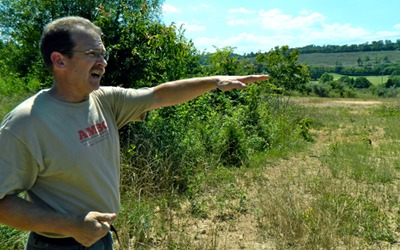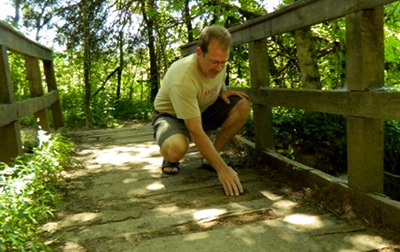
Steve Dittner, president of Friends of Haw Ridge, talks about plans to build a bike skills area on unfinished soccer fields off Edgemoor Road in Oak Ridge.
A city board has recommended that horses be banned from Haw Ridge Park for now, and a nonprofit organization that helps maintain the park wants to build a bike skills area on an abandoned, unfinished soccer field off Edgemoor Road.
Friends of Haw Ridge expects to vote on a plan for the bike skills area on June 28, said Steve Dittner, the organization’s president. The plan could then be presented to the city.
The skills area will give mountain bikers a safe introduction to the challenges they will face on the 28 miles of wooded, dirt trails in the 780-acre Haw Ridge Park, Dittner said.
“It’ll have things you’ll encounter in the area,” he said, including bridges, log rides, and “skinnies,” which are narrow boards or logs suspended above the ground.
The skills area will recycle playground materials from the rebuilt Cedar Hill Park and could cost between $1,000 and $1,500, Dittner said. The first phase might take a day to complete.
More advanced obstacles could be added later, Dittner said.
Bike skills areas in other cities such as Longmont and Frisco, Colo., draw many bike tourists, Dittner said.
He said Haw Ridge presents plenty of challenges to mountain bikers, runners, hikers, and walkers, including steep descents, lung-busting climbs, and tree roots in trails.
“Haw Ridge is a really rocky mess,” Dittner said.
Inexperienced users can get lost in the wilderness area, he said.
Dittner said Friends of Haw Ridge, which maintains the park’s narrow trails, has not had an official position on whether to ban horses.
Although relatively few horse owners use the park, the few who use off-limit trails cause problems for others, Dittner said.
Most of the park’s single-track trails are two to three feet wide, and they are not built to withstand the weight and impact of a horse, Dittner said. Only three of the 40 trails are horse-friendly.
“Reluctantly, we have agreed to go along with the removal of horses as one of the user groups,” he said.
Earlier this month, the Oak Ridge Recreation and Parks Advisory Board recommended that horses be banned until horse owners can work together to develop a solution that allows them to “co-exist with other users” and stay on approved trails. Essentially, they need to “self-police to use trails that are sustainable,” Dittner said.
He said heavy horses and their sharp hooves can create pockets in narrow trails, which then become hard-to-remove mud pits. Horses can also knock off trails edges, reducing their widths.
“It creates a much more dangerous situation for riders, walkers, and hikers,” Dittner said.

Susie Williams Taylor says
This seems like a great idea…interesting, informative article!
John Huotari says
I thought it was an interesting idea also, Susie. I had never heard of a bike skills area until I did this story.